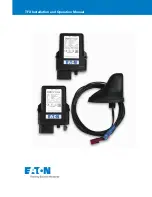
Maintenance
24
De-icer check
Periodically (we suggest at the end of each winter season), check the condi-
tion of the de-icer wiring with an ammeter; compare the legs of the system
with each other and with initial readings taken at installation. If an ammeter is
not available, resistance readings of each leg will suffice.
Paint
The radiators should never be painted (a coating of paint affects VSWR), and
they need no surface protection, since they are made of copper and brass.
This includes Teflon or other "ice-prevention" coatings.
It is not necessary to paint the feedline, although no harm will result from
doing so.
Radiator removal for
repair
In some cases, a damaged radiator may be removed and returned to the fac-
tory for repair. The system can then be sealed with a pressure cap, and opera-
tion of the antenna can resume with proportional power reduction and
increased VSWR.
See the Shively Web site, www.shively.com, for part numbers of pressure caps
and other components.
Operating with missing bays may not be possible with some transmitters or
antennas that have only a few bays, since some transmitters will not operate
into loads with high VSWRs. Contact Shively Labs before attempting this pro-
cess.
Return policy
When returning any material to the factory, be sure to call your salesman and
obtain an returned material authorization (RMA) number first. Use this num-
ber in all correspondence. This number helps us to track your returned item. It
will expedite repair or replacement and prevent loss of your material.
Troubleshooting
Cantact Shively Labs if necessary to help find the cause of your problem. Out-
side of 8:00 AM to 5:00 PM Eastern Time, call (207) 329-5118.
Internal arcing
The following may cause internal arcing:
• Physical damage to transmission line, feedline, or radiators. Dam-
age may have been caused by ice, lightning, tower work, or many
other factors. Damage may cause arcing directly or by allowing
water inside the system.
• Missing or misaligned O-ring, if the system has been opened
recently.
• Loss of pressurization.
Broad spectrum RF noise
This indicates that some metal components are not in good electrical contact
with the tower. First, check your antenna mounts, then other tower compo-
nents, to be sure that the tower paint has been scraped away and that all
mounting hardware is tight.
Any metal part in poor contact with the tower will constitute a non-linear junc-
tion and cast a broad-spectrum signal. This includes antennas, transmission
line, mounts, ladders, and other electrical components.





































